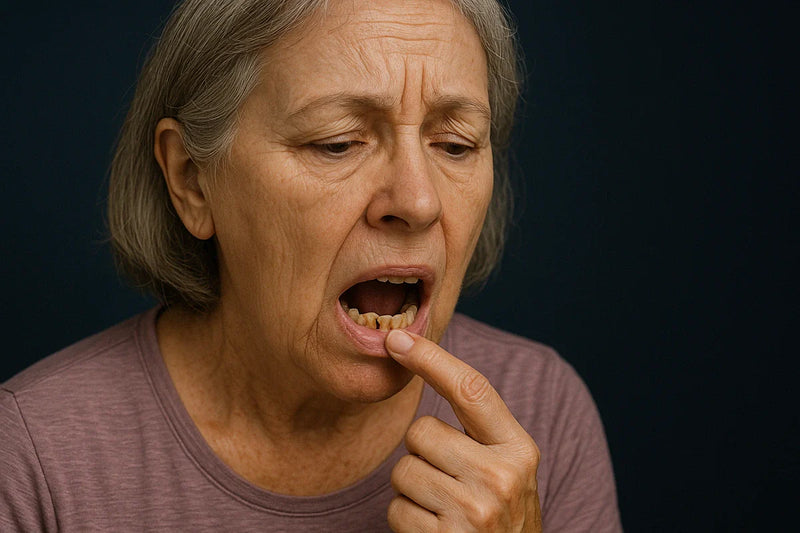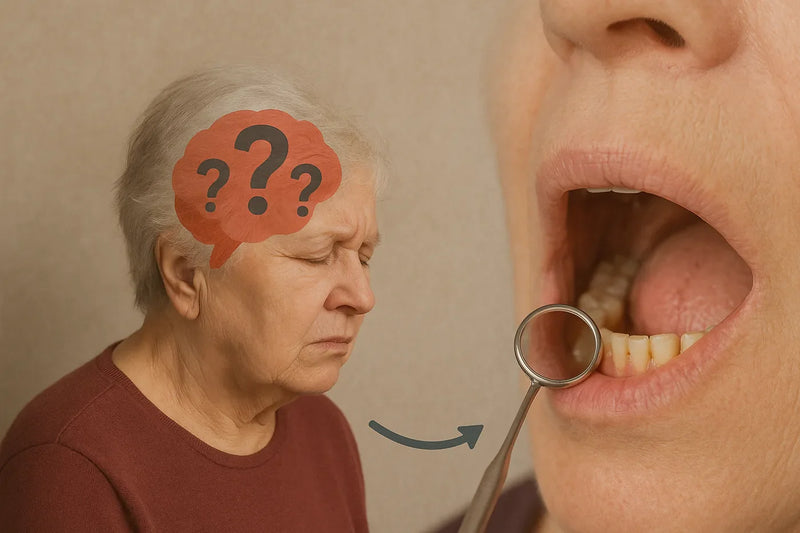
Brushing & Flossing Techniques For Gum Health
Essential Takeaways
- Healthy gums are vital for overall well-being as they secure teeth and protect deeper tissues from bacteria.
- Use a soft-bristled, electric, or specially designed toothbrush (like a U-toothbrush) to gently remove plaque and reduce gingivitis.
- Adopt effective brushing techniques—hold the brush at a 45° angle and use circular motions; brush at least twice daily (morning, post-meal, and before bed).
- Incorporate proper flossing using tools such as floss threaders to reach interdental spaces and prevent plaque buildup.
- Complement your routine with natural remedies, a balanced diet, and regular dental check-ups for early intervention and sustained gum health.
Maintaining healthy gums is crucial not only for your oral health but also for your overall well-being. Gums serve as the foundation for your teeth, holding them securely in place and protecting the deeper tissues from bacteria. When neglected, your gum health can deteriorate, leading to gum disease, which might cause tooth loss and other health complications. Regular brushing, flossing, and professional dental care are essential steps in preserving the health of your gums. Incorporating the right techniques and tools, such as an electric toothbrush or a toothbrush for gum health, can make a significant difference in preventing gum disease and ensuring a healthy mouth.
Recommended Oral Care Products for Gum Health
A wide variety of oral hygiene products are available to support gum health, each playing a unique role in maintaining a healthy mouth. Toothbrushes come in different forms, including manual and electric options, with soft-bristled brushes generally recommended to minimize irritation to sensitive gum tissue. Toothpastes formulated with fluoride help strengthen teeth and protect against cavities, while some specialized varieties are designed to target gum health by reducing inflammation or providing antibacterial benefits. Floss is essential for cleaning between teeth and along the gumline, where toothbrushes cannot reach. By choosing the right combination of these products and using them consistently, individuals can effectively remove plaque, reduce the risk of gum disease, and maintain optimal gum health.
Indicators and Health Risks of Poor Oral Hygiene
Recognizing the signs of poor oral hygiene is crucial for preventing more serious health complications. Common indicators include bleeding gums, persistent bad breath, tooth decay, gum recession, and loose teeth. Individuals may also notice swelling of the gums or jaw, mouth sores that do not heal, and increased tooth sensitivity. These symptoms often indicate the accumulation of plaque and bacteria resulting from inadequate brushing and flossing. If left unaddressed, poor oral hygiene can progress to gum diseases such as gingivitis and periodontitis, which are marked by inflammation, infection, and potential tooth loss. Beyond the mouth, neglecting oral care has been linked to a range of systemic health conditions. Studies have shown that untreated gum disease can increase the risk of cardiovascular disease, stroke, and complications during pregnancy, such as premature birth and low birth weight. Additionally, chronic oral infections may contribute to respiratory illnesses like pneumonia and can exacerbate conditions such as diabetes and osteoporosis. Paying attention to early warning signs and maintaining a diligent oral hygiene routine is vital not only for preserving gum and tooth health but also for supporting overall well-being.
Selecting the Right Toothbrush
Traditional vs. Electric Toothbrushes
Choosing between a traditional toothbrush and an electric toothbrush can significantly impact your oral hygiene routine. Traditional toothbrushes are affordable and straightforward in their use, requiring manual control to remove plaque effectively. On the other hand, electric toothbrushes offer automated bristle movements that can be more effective in reducing plaque through consistent motion and pressure. For individuals with limited manual dexterity or specific dental needs, such as those with braces, an electric toothbrush can be particularly beneficial, ensuring thorough cleaning without the excessive pressure that could harm sensitive gums.

U-toothbrush and Mouth-shaped Toothbrush
These are innovative designs tailored to enhance gum and dental health through unique brushing experiences. The U-brush features a U-shaped head that wraps around the teeth, providing simultaneous cleaning on multiple surfaces, which can be especially effective for maintaining gum health. The mouth-shaped toothbrush, with its conforming design, offers comprehensive coverage, ensuring that all areas of the mouth, including hard-to-reach spots, receive equal attention during brushing, making it easier to remove plaque uniformly and gently.
Best Toothbrushes for Sensitive Teeth
Finding the best power toothbrush for sensitive teeth is crucial. These toothbrushes typically have softer bristles and adjustable power settings to reduce discomfort while thoroughly cleaning the gums and teeth. Features to look for include pressure sensors that alert you when brushing too hard, timers to promote even cleaning, and modes explicitly designed for gum care that gently massage the gums, promoting circulation and health.
How to Evaluate a Toothbrush for Gum Health
Look for toothbrushes with soft to medium bristles, as stiff bristles can damage sensitive gum tissues. An ergonomic handle can also help improve control and comfort, reducing the likelihood of applying excessive pressure during brushing. Additionally, check for the American Dental Association (ADA) seal of approval, which indicates the toothbrush has been evaluated for safety and effectiveness in removing plaque and reducing gum disease.
Mastering Brushing Techniques
Proper Brushing Techniques
The recommended methods and steps for effective tooth brushing include tool selection and specific motions to optimize gum health. Position the bristles of the brush at a 45-degree angle against the gums. This angle is particularly effective because it allows the tips of the bristles to gently slide under the gumline, targeting the area where plaque and bacteria tend to accumulate. As mentioned previously, the use of a soft-bristled brush is essential, as stiff bristles can be harsh on the gum tissue, potentially causing irritation or recession. Moreover, employing a soft, circular, or rolling motion while brushing not only ensures thorough cleaning but also minimizes the risk of gum abrasion.
Furthermore, comprehensive cleaning involves meticulous attention to all surfaces of each tooth. The outer surfaces that face the cheeks and lips, the inner surfaces closest to the tongue, and the biting surfaces must all receive equal care. It is often easy to neglect certain areas, especially the inner surfaces and the back molars, but these areas are just as susceptible to plaque buildup as more accessible areas.
Frequency and Timing of Brushing
Effective oral hygiene practices are fundamental to maintaining good dental health, with the frequency and timing of brushing playing critical roles. Establishing a routine that optimally mitigates plaque buildup and prevents gum disease is essential. Brushing your teeth at least twice a day is widely advised, with additional brushing sessions after meals greatly enhancing dental health. Below are specific strategies to incorporate brushing into your daily routine to achieve the best results:
- Morning Brushing: Begin your day by brushing your teeth before breakfast. This practice is crucial as it helps remove the bacteria that have multiplied during the night. Overnight, the mouth produces less saliva, which normally helps to wash away bacteria. As a result, bacteria thrive and form a film on the teeth and gums. By brushing first thing in the morning, you can disrupt this bacterial buildup, freshen your breath, and prepare your mouth for the day ahead, minimizing the potential for plaque formation and gum disease.
- Post-Meal Brushing: It is advisable to wait approximately 30 minutes after eating before brushing your teeth. This waiting period is important because it allows saliva, a natural defense mechanism against decay, to neutralize the acids produced by your meal. Acidic and sugary foods can temporarily weaken tooth enamel, and brushing too soon after eating can harm the enamel in its weakened state. By delaying brushing for a short period, you reduce the risk of eroding the enamel and provide an optimal environment for effectively cleaning your teeth without causing damage.
- Nighttime Brushing: Ensure you brush your teeth before going to bed each night. Nighttime brushing is essential because it removes food particles and plaque that have accumulated throughout the day. This prevents bacteria from feeding on these residues and producing harmful acids overnight, which can lead to tooth decay and gum disease. Additionally, brushing at night helps to reduce the growth of bacteria and freshens your mouth, setting a healthier environment while you sleep.
Effective brushing goes beyond just the act. It's about timing, technique, and consistency. By following these guidelines, you can keep your mouth clean and fresh, supporting your dental health in the long run.

Tips for Using Electric Toothbrushes
When using an electric toothbrush, it's crucial to let the tool do the work. Avoid pressing too hard; instead, guide it along the surfaces of your teeth and gums. Many electric toothbrushes come with built-in timers to help you spend the right amount of time on each section of your mouth, usually around two minutes. Additionally, replace the head of your electric toothbrush every three months or sooner if the bristles begin to fray, to maintain optimal effectiveness and hygiene.
Importance of Flossing
Why Flossing is Essential for Gum Health
Flossing plays an indispensable role in oral hygiene by targeting areas that are typically inaccessible to toothbrushes. The gaps between teeth and the narrow margins at the gumline are prime locations for the accumulation of plaque. If not removed, plaque hardens into tartar, a rough substance that can only be professionally cleaned away. Moreover, the benefits of flossing extend beyond just protecting the gums; it also plays a significant role in overall dental health. By removing trapped food particles and plaque from between the teeth, flossing helps to prevent the formation of cavities in these hard-to-reach areas. Additionally, since the breakdown of lingering food by oral bacteria is a major cause of halitosis, flossing best practices help maintain fresher breath by eliminating these potential sources of odor. This contributes to a cleaner, healthier mouth, enhancing one’s confidence and social interactions.
Effective Flossing Methods
Learn the correct techniques for flossing to effectively remove plaque and debris between teeth and along the gumline. Use about 18 inches of floss, winding most of it around each middle finger and leaving an inch or two to work with. Gently slide it up and down between the teeth, following the curves of each tooth and ensuring you dip beneath the gumline but without snapping the floss into the gums, which can cause damage. Utilize a clean section of floss for each tooth to avoid reinserting bacteria you just removed. These practices help ensure that your flossing is thorough and beneficial for your gum health.
Choosing the Right Type of Floss
Selecting the appropriate type of floss for your dental needs can enhance its effectiveness. Waxed floss is excellent for teeth that are tightly spaced, as it slides more easily into small gaps. Unwaxed floss tends to squeak against clean teeth, indicating plaque has been removed, and is best for slightly larger gaps. For those with braces or bridges, a floss threader or specialized orthodontic floss can facilitate cleaning around dental appliances. Always consider your dental condition when choosing floss to ensure optimal gum care.
Individuals with sensitive gums should take extra care when flossing to avoid further irritation. Start by using softer, gentler floss that is designed for sensitive gums. When flossing, apply gentle pressure and take care to glide the floss smoothly around each tooth and just below the gum line. This technique helps to remove plaque without causing undue stress on the gums, reducing the risk of bleeding or inflammation. If discomfort persists, consult with your dentist to explore additional gum health remedies that can be integrated into your oral care routine.
Supplements and Natural Remedies
Supplements for Gum Health
Certain vitamins and minerals, such as Vitamin C, Vitamin D, and calcium, are known for their role in maintaining the integrity and resilience of gum tissue. Vitamin C, for example, is crucial for collagen production, a vital component of gum tissue, and helps prevent the inflammation that leads to gum disease. Similarly, Vitamin D is instrumental in creating an environment that discourages the growth of harmful bacteria in the mouth. When choosing gum health supplements, it’s important to consult with a healthcare provider to ensure they're appropriate for your specific health needs and do not interfere with other medications.
Natural Remedies to Support Gum Health
These remedies, often derived from common household ingredients, offer anti-inflammatory, antibacterial, and soothing properties that can enhance gum care when used alongside regular brushing and flossing. Here are some effective natural remedies that you can easily incorporate into your daily oral health regimen:
- Saltwater Rinse: Utilizing a saltwater rinse can significantly help in reducing gum inflammation and cleansing the mouth of harmful bacteria. To prepare this rinse, dissolve one teaspoon of salt in a cup of warm water. Swish the solution around in your mouth for about 30 seconds, ensuring that it reaches all parts of your gums and teeth, then spit it out. This process can be done several times a week to help reduce bacterial buildup and soothe inflamed gums.
- Tea Tree Oil: Tea tree oil is celebrated for its potent anti-inflammatory and antibacterial properties. To use tea tree oil for gum health, add a couple of drops to your toothpaste or into a cup of water to use as a mouthwash. It is crucial to use a diluted form of tea tree oil, as undiluted oil can be too harsh and may cause irritation. Regular use can help in fighting bacteria that cause gum disease and promote the healing of gum tissue.
- Aloe Vera: It has a soothing effect and can aid in repairing damaged tissues, making it an excellent remedy for inflamed gums. After your regular brushing and flossing, apply a small amount of aloe vera gel to your gums and gently massage it in. This can help soothe irritation and promote healing in the gum tissue. Aloe vera is gentle and can be used daily for its soothing and healing properties.
- Turmeric Gel: Turmeric contains curcumin, known for its strong anti-inflammatory effects, making it effective in managing gum inflammation and other symptoms of gingivitis. Apply a small amount of turmeric gel to the gums, leaving it on for a few minutes before rinsing it off. This can be done daily to reduce inflammation and support healthy gum tissue.
By adopting these natural remedies, you can add a layer of care to your dental health routine that supports and maintains gum health. These remedies, while beneficial, should complement rather than replace traditional oral hygiene practices such as brushing, flossing, and regular dental check-ups. Together, these practices can help ensure that your gums remain healthy.

Maintaining Healthy Gums Through Daily Routines
Lifestyle Changes to Benefit Gum Health
Avoiding sugary snacks and beverages helps prevent the formation of plaque and tartar. Smoking cessation is another critical lifestyle change; smoking is strongly linked to the development of gum disease, as it impairs gum tissue repair. By making these adjustments, you can significantly improve gum health and overall oral hygiene.
Advanced Care Techniques
For those looking to go beyond basic care, advanced techniques such as water flossing can be highly beneficial. Water flossers use a high-pressure stream of water to remove plaque and food particles from between teeth and under the gum line. This can be particularly helpful for people with braces or other dental devices. Another advanced technique used by dental professionals is laser therapy, which targets and reduces bacteria and inflammation in gum pockets.
Continued education about oral health is vital for long-term gum health. Stay updated with the latest dental care practices and products. Regular visits to your dentist for professional advice and treatment are irreplaceable parts of keeping healthy gums. Furthermore, always be open to modifying your oral hygiene routine based on the latest research and your dentist's recommendations to adapt to changing health needs. Support your gum health with advanced toothbrushes designed for comfort and effectiveness, available now at Feno. This ongoing commitment to learning and adaptation is the cornerstone of effective gum health tips and ensures your oral hygiene practices remain effective over time.

Feno Founders Edition Bundle
Advanced Oral Health in 20 Seconds with the Feno Smartbrush™
Get Yours Now!





